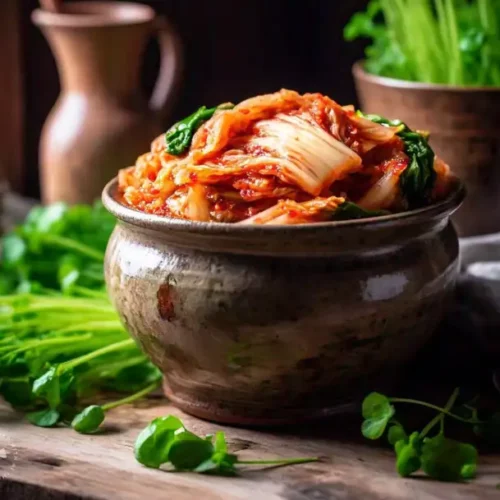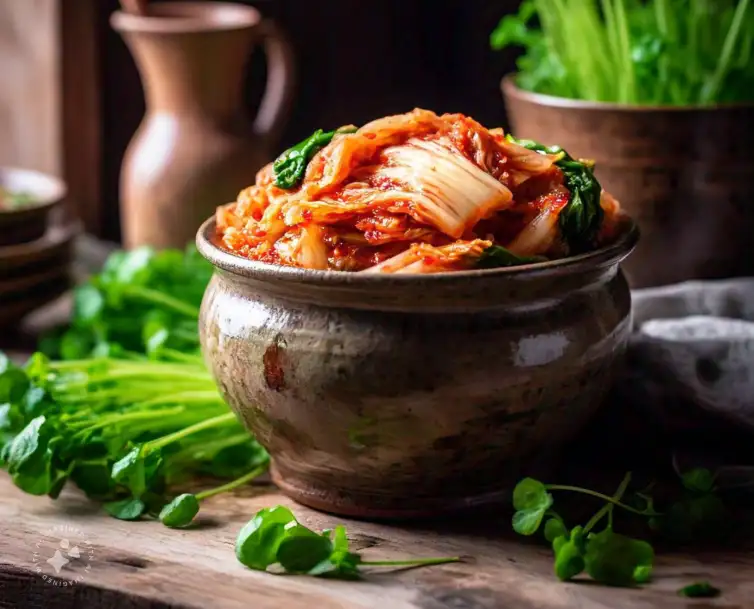Kimchi watercress combines the bold, spicy tang of kimchi with the peppery, fresh crunch of watercress. Whether you’re a seasoned kimchi maker or just starting, this fusion dish is versatile, nutritious, and easy to prepare. Here’s everything you need to know about this delightful combination, covering recipes, benefits, and its cultural significance.

Kimchi Watercress Recipe
This kimchi watercress recipe draws inspiration from both traditional Korean methods and creative adaptations. It’s simple, uses easy-to-find ingredients, and adds unique flavor and texture.
Ingredients
- 2 tablespoons sweet rice flour or all-purpose flour
- ½ cup water
- 2 bunches scallions cleaned and trimmed
- 2 teaspoons kosher salt
- 1 bunch watercress thick stems removed
- 1 tablespoon minced garlic
- 1 tablespoon minced ginger
- 2-3 tablespoons Korean pepper flakes or ½ teaspoon crushed red pepper flakes + ⅛ teaspoon smoked paprika
- 2 teaspoons brown sugar
- 1 teaspoon coarse salt e.g., Maldon or fleur de sel
Instructions
Make the Flour Paste:
- Whisk together the flour and water in a small saucepan. Cook over medium heat, stirring constantly, until it thickens like glue (about 2 minutes). Let cool.
Prepare Vegetables:
- Cut scallions into 1–2 inch lengths and toss with 2 teaspoons of kosher salt. Let sit for 20 minutes, then drain any accumulated liquid.
- Tear watercress into bite-sized pieces.
Mix Ingredients:
- In a large bowl, combine scallions, watercress, garlic, ginger, pepper flakes, sugar, and coarse salt. Mix with gloved hands, gradually adding the flour paste until well-coated. Adjust seasoning to taste.
Fermentation:
- Pack the mixture into glass jars, leaving about ¾-inch headspace. Seal tightly and ferment at room temperature for 2 days, flipping the jars every 12 hours to distribute liquids.
- Open the jars daily to release gas pressure. After 2 days, refrigerate and allow at least 5 days for optimal flavor.
- This kimchi will stay fresh for a month in the fridge and can be eaten at any stage of fermentation.
Health Benefits of Kimchi Watercress
- Nutritional Boost:
- Kimchi is rich in probiotics that support gut health and digestion.
- Watercress adds vitamins A, C, and K, along with antioxidants and anti-inflammatory properties.
- Low-Calorie Superfood:
- Both ingredients are low in calories but high in nutrients, making them perfect for health-conscious diets.
- Enhanced Texture and Flavor:
- Watercress introduces a crisp texture that complements the softness of traditional kimchi vegetables.
Cultural Significance and Adaptations
- Traditional Roots:
- While napa cabbage and radishes are staples in Korean kimchi, watercress offers a creative twist. Its crunchy, water-grown stems resemble minari (a traditional Korean vegetable).
- Modern Variations:
- Watercress is an excellent substitute for minari in water-based kimchi like nabak kimchi.
- This version pairs well with sandwiches, rice bowls, savory pancakes, or as a soup garnish.
Tips for Incorporating Kimchi Watercress
- Culinary Pairings:
- Add to noodle bowls for extra zing.
- Use as a topping for crostini or mix into salads.
- Enhance soups or savory breakfast pancakes with a dollop.
- Substitute Ingredients:
- If Korean red pepper flakes are unavailable, use crushed red pepper with a pinch of smoked paprika.
Why Choose Watercress in Kimchi?
- Similarities to Minari:
- Like minari, watercress thrives in water and has hollow stems, offering a satisfying crunch.
- Accessibility:
- Watercress is easier to find in many Western markets, making it a convenient alternative.
Kimchi watercress is not just a dish but a celebration of adaptability and creativity in the kitchen. With its bold flavors, crunchy textures, and numerous health benefits, this fusion recipe is a must-try for anyone looking to elevate their culinary repertoire.

